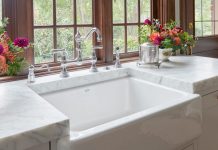“Classic, timeless style,” says interior designer Carolyn Nierenberg of Campbell Design Associates when asked to define a luxury home.
“Luxury stands the test of time, and it won’t do that if it’s trendy.”
She put this mantra to work when approached by a couple looking to downsize to a luxurious space with a little less land to maintain.
“They had so much land to care for, so they wanted to find a similar house with the big, open spaces they enjoy but with a little less upkeep,” Nierenberg says, and adds that another requirement was plenty of room for their grown children and families to use when visiting.
Her clients’ criteria for the home also included plenty of floor-to-ceiling windows, smart use of space and an uncluttered feel.
When her clients couldn’t find the exact home they were looking for, Nierenberg, along with Tulsa architect Mike Dankbar, helped create a modified Mediterranean style home with a crisp limestone exterior and classic tile roofing.
The expert team had every art piece, furnishing and light fixture planned before a single stone was laid. Every space was designed with exact purpose, from the great room – which opens to the other main living areas – to the lavish outdoor accommodations.
“They wanted an eclectic style that wasn’t so modern that it didn’t fit the neighborhood,” Nierenberg says.
The modified elements of the classic Mediterranean style can be seen in the use of polished limestone for the exterior and the mix of tailored furniture pieces alongside primitive antiques.
Nierenberg used antique beams with iron straps throughout the great room and dining room. Another standout piece is the 200-year-old door imported from France that was turned into a table with a modern iron base and thick glass covering.
The furnishings were specially selected for the home and work in harmony with the natural color palette of the residence, which is created in part by an exuberant use of natural materials.
A selection of art and furnishings adds pops of color and a modern touch to this residence.
The use of natural materials also helps create a strong relationship between indoor and outdoor spaces. This relationship is enhanced by the interplay of ceiling height with large expanses of windows.
This is especially evident in the great room, where Nierenberg says Dankbar created an exquisite exchange between the interior and exterior living spaces with floor-to-ceiling windows with three sets of French doors leading to an outdoor pool, kitchen and sitting areas. Interlacing courtyards, each with private access, further connect the indoor with the outdoor.


























